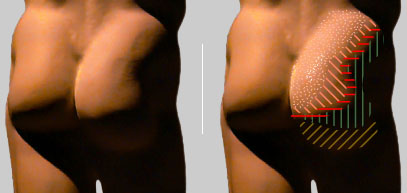
Halftones are identified by their combined mix of shade, cast shadows and light.
The halftone is found on the boundary between shade and light where textured form is turning from the light. The halftone is not the edge of a cast shadow. Compared to the total area of the illuminated and shaded zones, the halftone is a rather narrow band. Because different forms turn from the light with various radii, the half tone bands will vary in width, accordingly.
Implications:
Because this is the specific area where textural relief actually casts shadows on the form itself, this is the area where artwork can express texture for truthful representation.

Back to: Shade, Light & Form Modeling Entrance | Definitions/TopicsBelow:Magnification. The upper left corner -- where the true shade is NOT present -- is not part of the halftone.
The bumps that DO turn from the light contain true shade (and they cast shadows), and define the beginning of the halftone band. When the whole mass turns out of the light, the halftone terminates and the form is now in true shade.
Notice the halftone area macroscopically contains the greatest value contrast between dark and light. This is where texture is most apparent.